What Shoes Can I Wear On A Golf Course
What Shoes Can I Wear On A Golf Course? When you play golf, you need shoes that help you stay balanced and won’t hurt the grass.
The best choice is golf shoes with soft spikes or spikeless golf shoes. These shoes give you a good grip and help your swing stay strong. Brands like Nike, Adidas, and FootJoy make great golf shoes.
If you don’t have golf shoes, you can wear clean running shoes or sneakers that have rubber soles and good traction.
But don’t wear metal spikes, sandals, or boots, because they can damage the golf course, and most places don’t allow them.
Before you go, always check the golf course dress code to make sure your shoes are okay.
What Shoes Can I Wear on a Golf Course – A Golf Pro Explains for Beginners
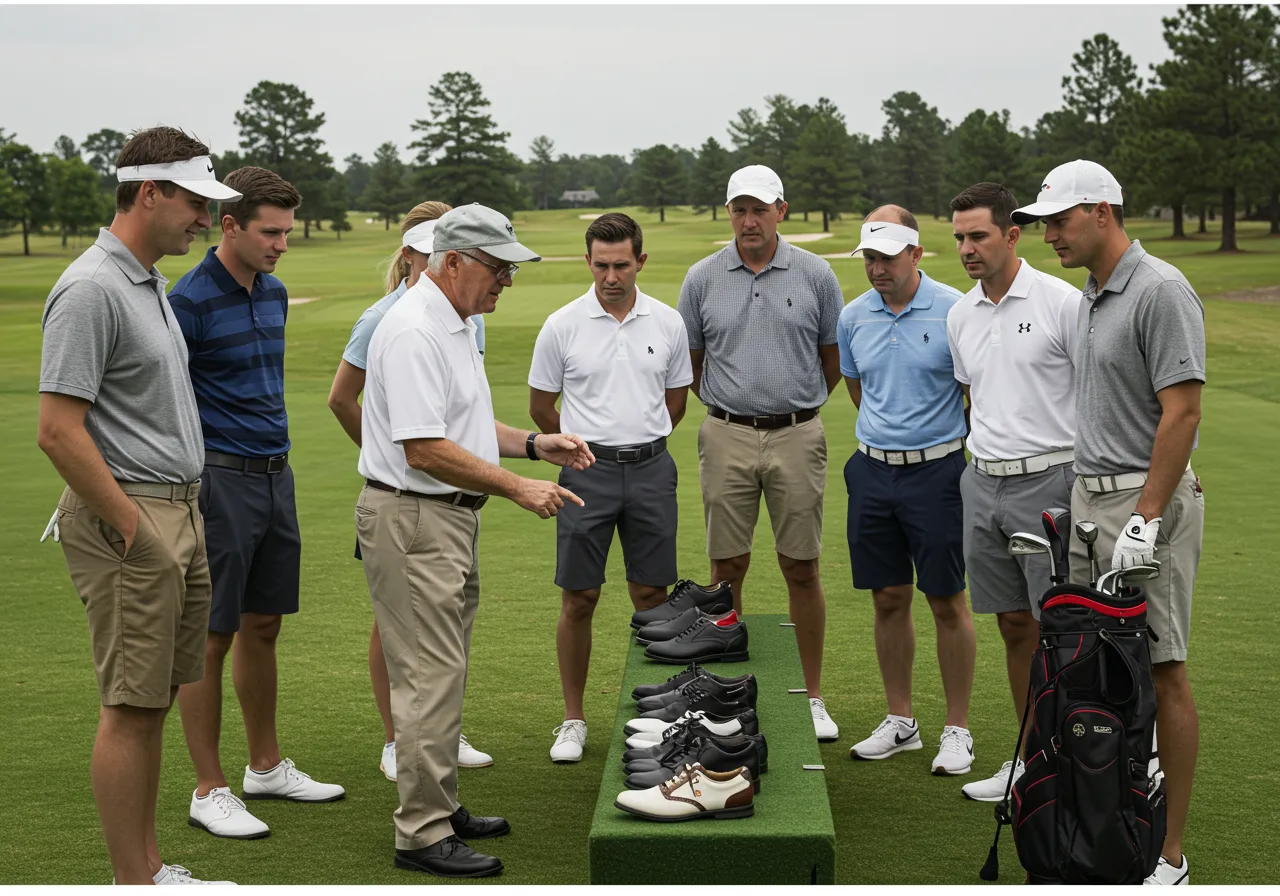
“Over 65% of new players wear the wrong shoes, and it shows in their swing.”
I’ve been playing golf for over 15 years and have coached many beginners.
The first thing I always teach is this: your shoes matter. Wearing the right shoes helps your balance, swing, and confidence. It also shows respect for the course.
Best Footwear Options for Playing Golf: Detailed Comparison Table
| Shoe Type | Course Approval | Grip & Traction | Comfort (18 Holes) | Weather Fit | Durability | Beginner Friendly | Average Price (USD) | Use Case Example | Popular Models |
| Spikeless Golf Shoes | Approved at most clubs | Good on dry & soft turf | Very High | All-season (with waterproof) | Long-lasting soles | Yes | $70–$140 | General rounds, range practice, walking courses | Nike Roshe G, Adidas CodeChaos, FootJoy Flex |
| Athletic Sneakers | Sometimes allowed | Moderate (depends on sole) | Very High | Dry conditions only | Wears faster on turf | Partially | $50–$120 | Beginners without golf gear, range use | Brooks Ghost, New Balance 860 |
| Soft-Spike Golf Shoes | Approved but heavier | Excellent on all turf | Moderate (can feel stiff) | Excellent in wet | Very Durable | Yes (if fit is right) | $90–$180 | Competitive play, wet or hilly courses | FootJoy Traditions, Adidas ZG23 |
| Trail Running Shoes | Sometimes allowed (public only) | Fair on firm ground | High | Good in mixed weather | Moderate wear | Somewhat | $60–$130 | Public courses, practice rounds | Salomon Sense Ride, Hoka Challenger ATR |
| Metal Spike Shoes | Mostly banned (legacy only) | Top-level grip | Low | Good, but damages the turf | High, but banned | No | $80–$150 | Rare use, mostly obsolete | (Legacy only, not recommended) |
Note: This table compares the top 5 shoe types golfers may consider wearing on a course.
Best Shoes to Wear on a Golf Course for First-Time Players
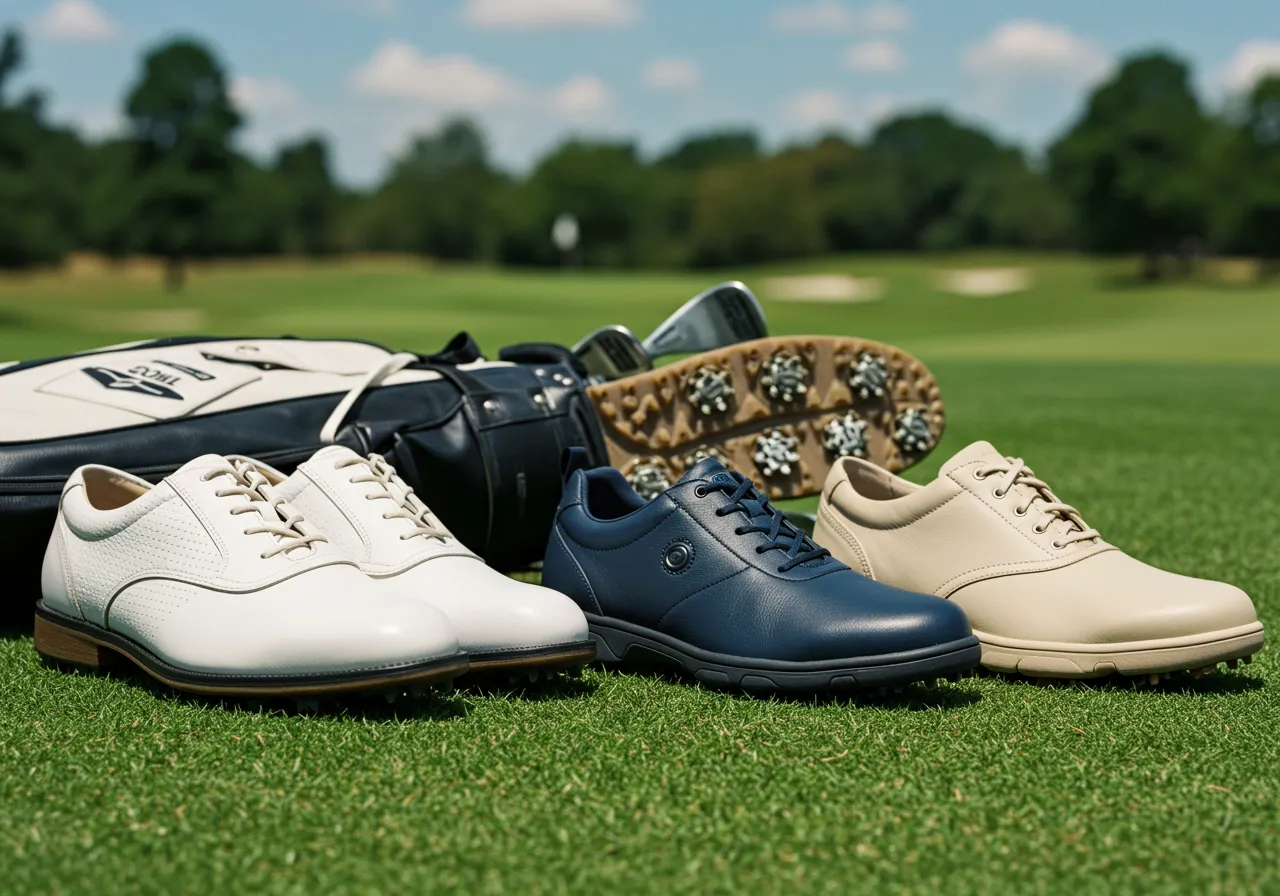
If you’re new to golf, the best choice is spikeless golf shoes. They are comfortable like sneakers but made for the course.
Brands like Nike, FootJoy, and Adidas make great beginner options. These shoes give you a strong grip, good balance, and comfort for walking all day.
What If I Don’t Have Golf Shoes Yet: Best Alternative Shoes for Golf Courses
If you don’t own golf shoes yet, many public courses let you wear clean running shoes or sneakers with rubber soles.
Trail runners can also work if they have grip. Just make sure the soles are flat and won’t damage the grass. I always tell beginners to avoid shoes that slip or slide during the swing.
Shoes You Should Never Wear on a Golf Course
Some shoes can damage the course or break dress code rules. These include metal-spike shoes, sandals, boots, and dress shoes.
Most golf courses will not allow these, and you might not be allowed to play if you wear them. Always wear shoes that protect the turf.
Why Spikeless Golf Shoes Are Best for Beginners and Casual Players
Spikeless golf shoes are a smart choice if you’re just starting. They feel like regular sneakers but are built for golf.
They work well on dry courses, driving ranges, and practice greens. Some of my favorite beginner-friendly pairs are Adidas CodeChaos, Nike Roshe G, and FootJoy Flex.
Always Check the Golf Course Footwear Rules Before You Go
Not all golf courses have the same rules. Some allow sneakers, some do not.
Before you show up, call the clubhouse or check the course’s website to see what types of shoes are allowed. It’s a simple step that helps you feel more prepared and confident.
Golf Course Shoe Rules: What Shoes Are Allowed and Banned on a Golf Course
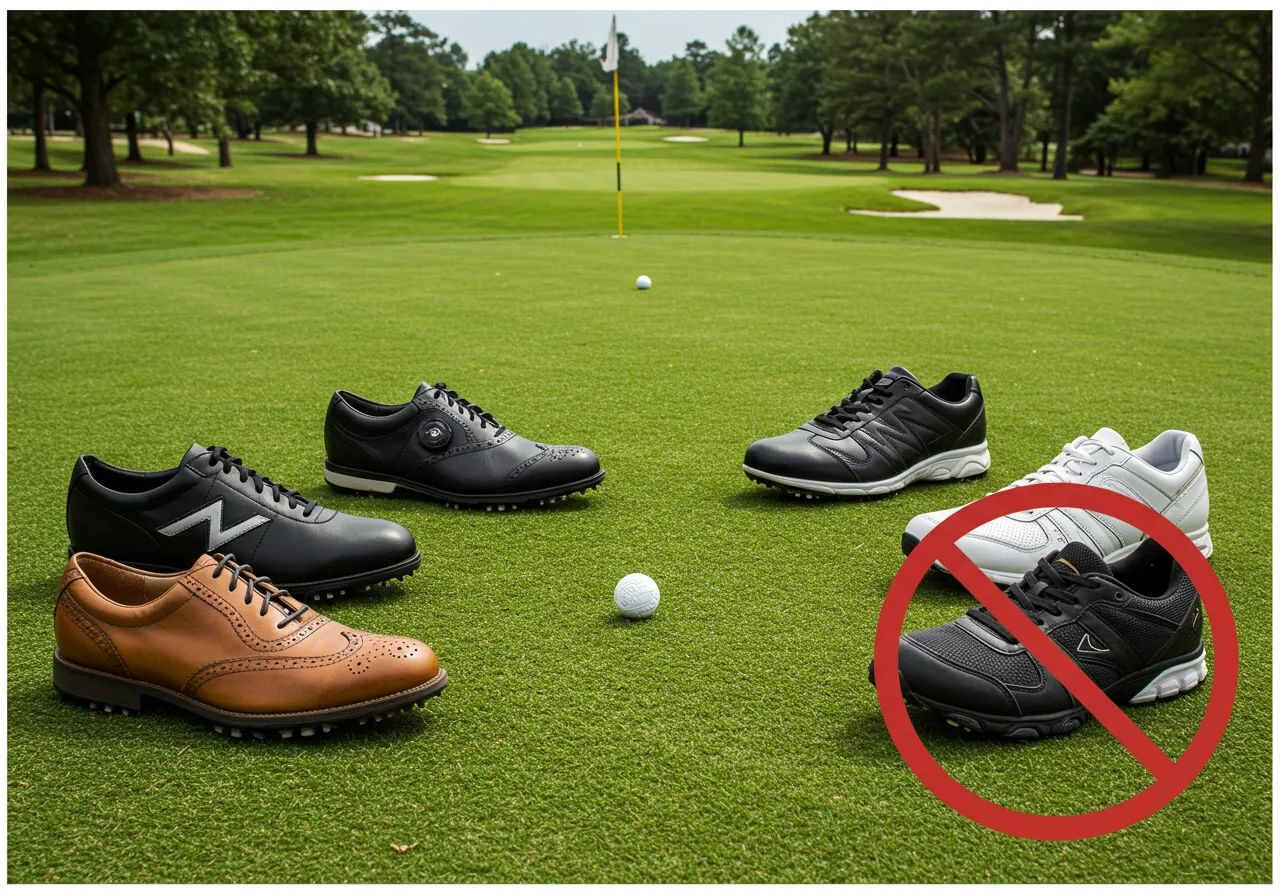
After coaching hundreds of new players, I’ve seen how often shoes become a problem. Many golfers don’t know the rules and show up in the wrong footwear.
Golf shoes aren’t just about style; they protect the grass, improve your grip, and follow the course’s dress code. Here’s what you need to know.
What Shoes Are Not Allowed on a Golf Course and Why You Should Avoid Them
Some shoes can damage the grass or make your swing unstable. From my experience, these types are almost always banned:
- Metal spike golf shoes – These tear up the greens and are not allowed at most modern clubs.
- Sandals or flip-flops – Unsafe and not part of the golf dress code.
- Work boots or heavy shoes – Too bulky and rough on the course surface.
- Trail running shoes with big treads – The thick soles can leave deep marks on soft turf.
If your shoes have deep grips or exposed metal, leave them at home. They don’t just hurt the grass; they also make it harder for you to swing with balance.
What Shoes Are Always Approved for Golf Courses
The safest and most accepted shoes for golf are made for the game. These include:
- Spikeless golf shoes – They look like regular sneakers but have flat, grippy soles that won’t damage the turf. Great for beginners and walking.
- Soft-spike golf shoes – These have small rubber cleats that grip the grass but protect the green.
- Golf sneakers or hybrid shoes – Brands like Adidas, Nike, and FootJoy make great shoes that work both on and off the course.
These shoes help your balance, improve traction, and are accepted almost everywhere, from public courses to private clubs.
Do Golf Courses Have Different Shoe Rules for Public and Private Clubs
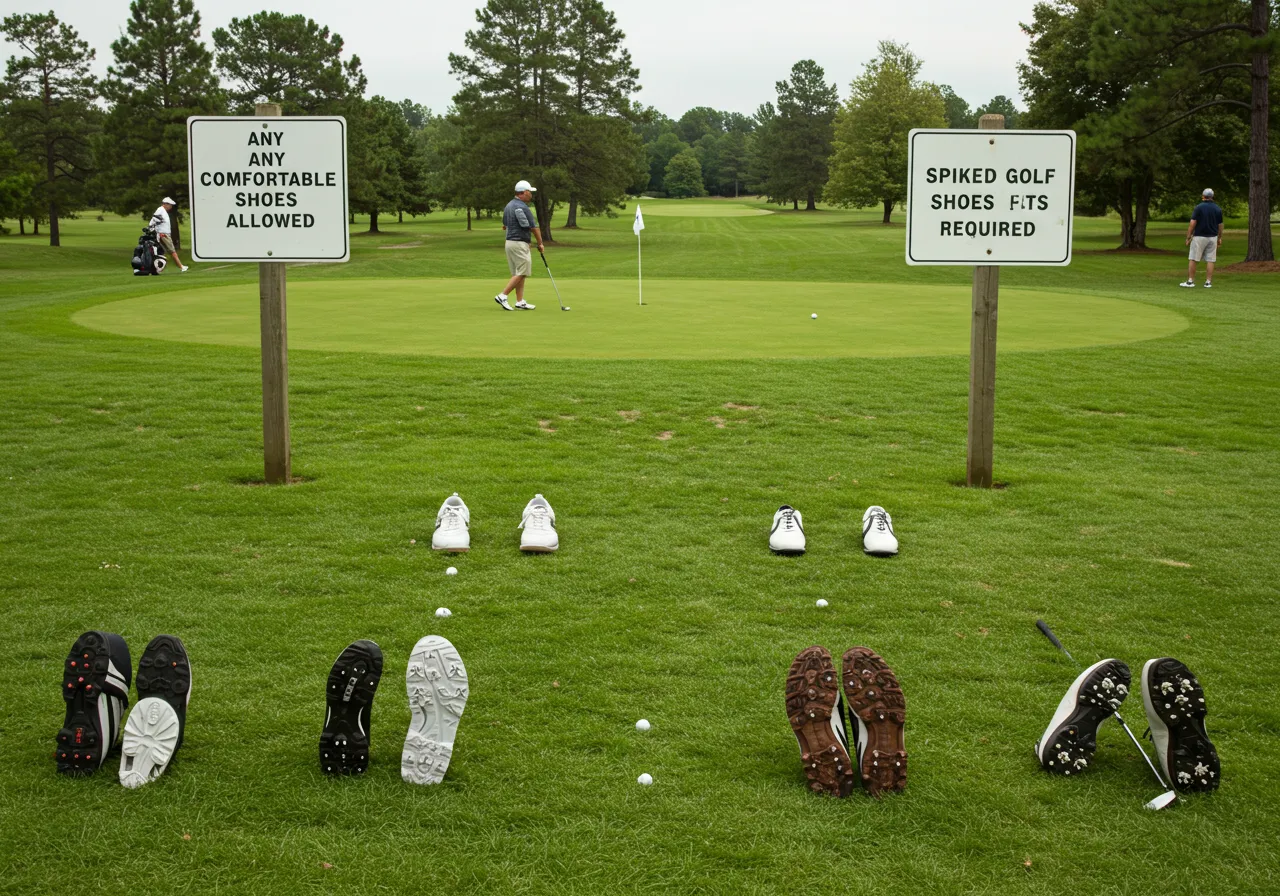
Yes, and I always remind new golfers to check before they show up. Different courses follow different rules:
- Public courses – These are more relaxed. Many will allow clean rubber-soled sneakers or athletic shoes if they don’t have big treads.
- Private clubs – These follow strict dress code policies. You’ll likely need real golf shoes to play, especially during tournaments.
My tip: Check the course website or call the front desk before your round. It only takes a minute, and it saves you from being turned away or told to change your shoes.
Golf Course Shoe Rules: What’s Allowed and What’s Not
| Shoe Type | Allowed on Most Courses? | Turf Friendly? | Grip for Golf? | Beginner Friendly? | Notes from a Golf Pro |
| Spikeless Golf Shoes | Yes | Yes | Good | Yes | Great for walking and dry weather. Look like sneakers but are made for golf. |
| Soft-Spike Golf Shoes | Yes | Yes | Excellent | Yes | Best for grip on hills and wet grass. Used in most tournaments. |
| Metal-Spike Golf Shoes | No (Mostly banned) | No | Excellent | No | Damages the greens. Rarely allowed anymore. |
| Running Shoes (flat sole) | Sometimes (public courses) | Yes (some) | Fair | Yes (starter option) | Okay for casual play. Must have a good grip and clean soles. |
| Trail or Hiking Shoes | No | No | Too aggressive | No | Thick soles damage grass. Not golf-approved. |
| Sandals or Flip-Flops | No | No | None | No | Unsafe and never allowed on any course. |
| Work Boots or Dress Shoes | No | No | Poor | No | Too heavy or slippery. Not made for sports. |
Note: This table is based on real-world golf course policies observed across both public and private clubs, combined with industry recommendations from golf brands like FootJoy, Adidas, and Nike.
Can You Wear Regular Shoes on a Golf Course: A Golf Pro Answers Common Questions
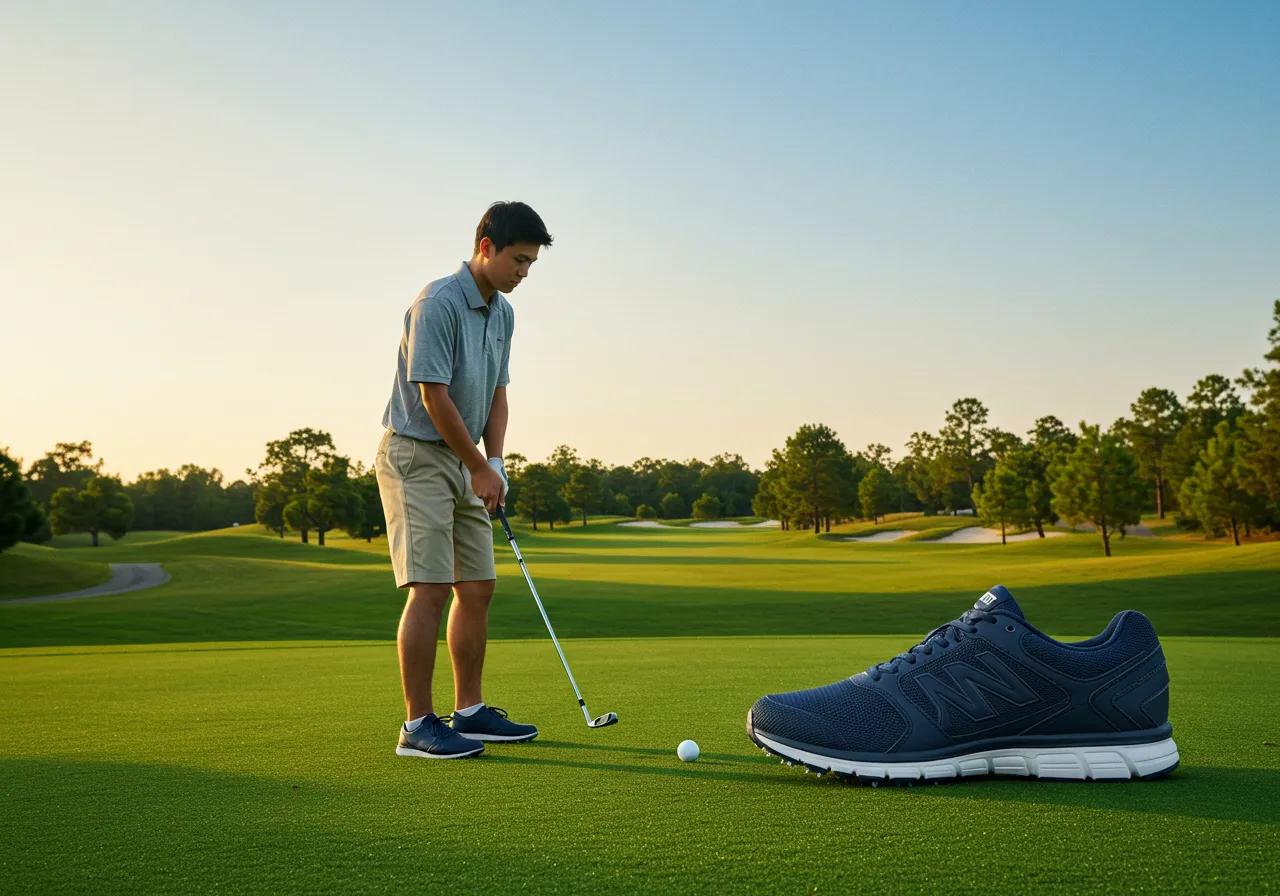
As a golf coach, one of the first questions I hear from new players is, “Can I wear my normal sneakers to play golf?”
It’s a good question, and the answer depends on the course and the kind of shoes you have. Let me walk you through what you really need to know.
Are You Allowed to Wear Sneakers or Regular Shoes on a Golf Course
The short answer is sometimes. Clean, flat-soled athletic shoes like tennis shoes or running shoes are allowed at many public golf courses, especially if you’re playing casually or at the driving range.
But they must have a good grip, be clean with rubber soles, and not leave deep marks on the grass.
I’ve had beginners show up in clean sneakers and play just fine, but they still didn’t have as much traction as golf shoes.
On private courses, sneakers are often not allowed, and golf shoes are required by the dress code.
What Happens If You Wear the Wrong Shoes on the Course
I’ve seen it happen many times: someone shows up in sandals, boots, or muddy trail shoes and gets told they can’t play. If you wear the wrong shoes, you might:
- Slip during your swing
- Damage the grass or greens
- Get denied entry to the course or be asked to change shoes
Even if the course doesn’t stop you, wearing the wrong shoes will likely affect your game. I always tell my students: the wrong shoes can cost you strokes.
Do You Really Need Golf Shoes to Start Playing
You don’t need to buy golf shoes right away, but they help a lot. Golf shoes are designed to:
- Keep your feet stable while swinging
- Protect the turf
- Help you walk long distances without pain
If you’re just learning and not sure you’ll stick with golf, clean sneakers are okay for now.
But if you plan to play often, it’s worth getting a pair of spikeless or soft-spike golf shoes. They make a big difference in how you play and feel.
Golf Shoe Alternatives for Beginners: What to Wear If You Don’t Have Golf Shoes
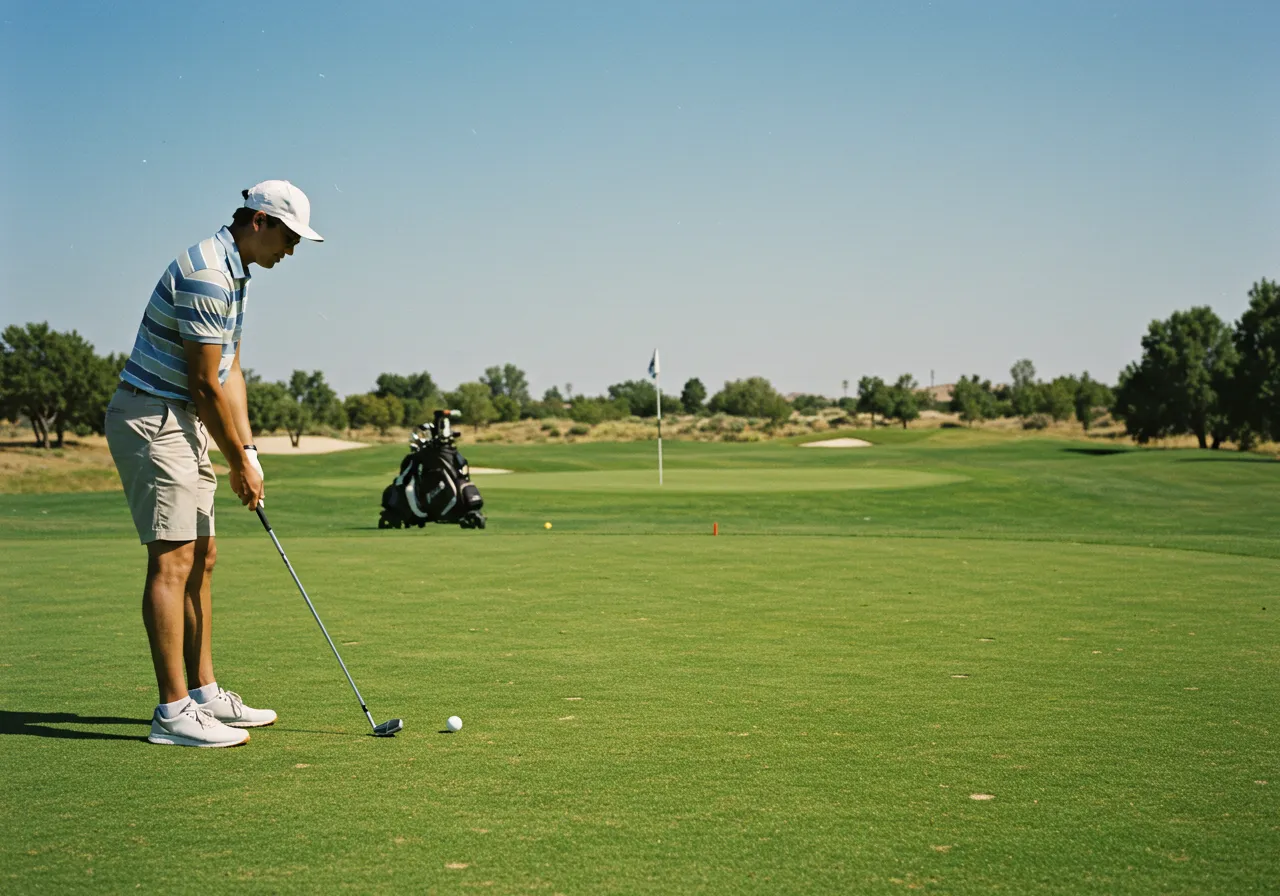
As a golf coach, I’ve worked with many players who showed up without golf shoes. Some didn’t know they were needed. Others didn’t want to spend money on gear right away.
That’s okay, there are some shoes you can wear in the beginning. But not all of them are good for your swing or the golf course.
What Are the Best Non-Golf Shoes You Can Wear for Playing Golf
If you don’t own golf shoes yet, there are a few decent options you can wear, as long as the course allows it.
- Trail running shoes – These have better grip than regular sneakers and are good for walking, but not great on wet grass.
- Minimalist sneakers – Light, flat-soled sneakers can work for driving range or dry weather rounds.
- Tennis shoes – These are sometimes allowed if they have a low tread and rubber soles.
I always tell beginners: make sure your shoes are clean, have a good grip, and don’t tear up the turf. It’s not just about playing, it’s about following golf etiquette too.
Can You Wear Vans or Running Shoes on a Golf Course
I get asked this a lot, and here’s the honest answer.
Vans or flat casual sneakers: These may look okay, but they have poor grip. Your feet will likely slip during your swing.
Running shoes: They’re made for moving forward, not side-to-side movement like in a golf swing. They often feel unstable when you turn.
From my experience, players who wear these shoes tend to lose balance or feel uncomfortable by the 9th hole. They might work once or twice, but they’re not good long-term.
What to Do If You Don’t Have Golf Shoes on Game Day
If you forget your shoes or don’t have any yet, here are a few smart solutions I always recommend to new players:
- Ask if the course rents golf shoes. Many clubs offer rentals at low prices.
- Borrow from a friend – If someone wears a similar size, this can be a quick fix.
- Use course-approved sneakers – Some public courses allow clean, grip-friendly sneakers for beginners. Always call ahead.
Golf is about learning step by step. You don’t need everything on day one, but having the right shoes helps you enjoy the game more and play with confidence.
Gender-Specific Golf Footwear: What Men and Women Should Wear on the Course

As a golf coach, I’ve helped both men and women choose the right shoes for their game. While the rules are mostly the same, the fit, style, and comfort needs can be different.
Golf shoes today are not just about performance; they also need to feel right and match your personal style.
What Golf Shoes Are Best for Men – Fit, Rules, and Comfort for Male Golfers
Men usually look for shoes that offer a strong grip and support. From my experience, these are the best options for male golfers:
- Leather golf shoes – These are classic and last a long time. Great for formal clubs and tournament play.
- Spikeless athletic hybrids – These look like running shoes but are made for golf. They’re lightweight and great for walking 18 holes.
- Soft-spike shoes – Best for grip in wet or hilly conditions. Many pros use these.
If you’re a beginner, I recommend spikeless shoes because they’re easier to wear and approved at most golf courses. Brands like FootJoy, Adidas, and Nike have great options for men.
What Golf Shoes Are Best for Women – Comfort and Style Tips from a Golf Coach
Women’s golf shoes have come a long way. Many of my female students want something that’s stylish and easy to walk in, and yes, you can have both.
- Knit spikeless golf shoes – These are soft, lightweight, and breathable. Great for warm weather and long rounds.
- Golf sandals – Some courses allow these if they have proper soles. Good for casual play in hot climates.
- Athletic-style golf sneakers – Just like men’s versions, these are easy to wear and offer solid grip and balance.
For women just starting out, I suggest spikeless knit shoes or golf sneakers. They’re easy to move in, look great, and won’t cause foot pain after walking the course.
Detailed Comparison Table: Best Golf Shoes for Beginners and Casual Golfers
| Type | Brand / Model | Key Feature | Best For | Pros | Cons | Price Range |
| Spikeless Hybrid | ECCO Biom H4 | Wear anywhere (on/off course) | All-day golfers, casual rounds, and travel use | – Comfortable fit like sneakers – Great grip without spikes – Looks good of course | – Expensive for beginners – Not ideal for muddy terrain | $$$ |
| Budget-Friendly | Adidas Tech Response | Strong traction at low cost | First-time players, budget buyers | – Lightweight and breathable – Soft spikes give a good grip – Affordable option | – Not waterproof – Basic styling | $ |
| All-Weather | FootJoy HydroKnit | Waterproof and flexible design | Rainy days, early morning tee times | – 100% waterproof – Athletic feel – Trusted brand for wet play | – Slightly bulky – Pricey for casual players | $$$ |
| Fashion-Forward | Nike Air Max 90 G | Sneaker-style with performance sole | Style-conscious golfers, weekend rounds | – Modern streetwear look – Comfortable for long walks – Brand appeal | – May not meet dress codes at formal clubs | $$ |
Note: This table compares some of the most recommended golf shoes based on a golf pro’s experience with real players.
Special Golf Shoe Rules for Different Situations and Places
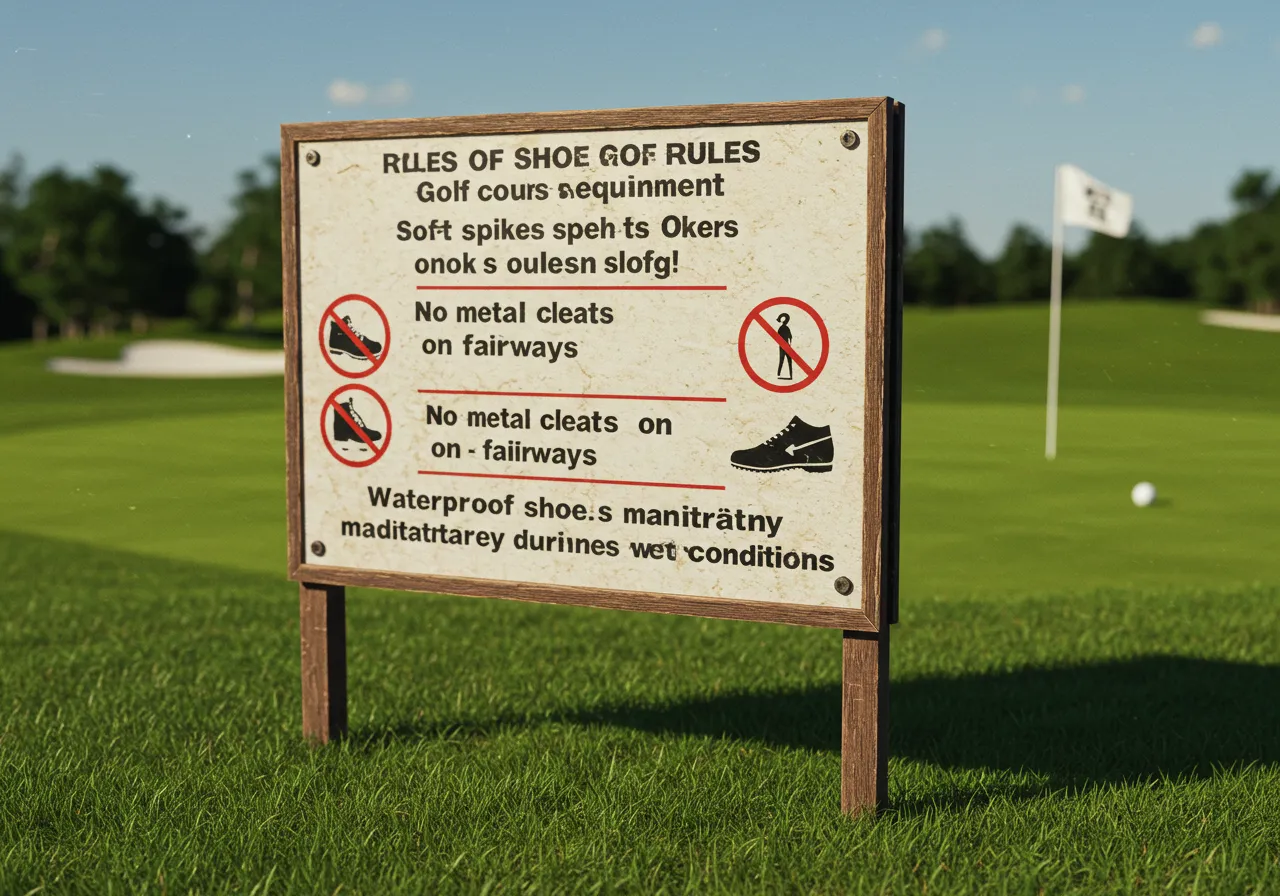
Over the years, I’ve seen all kinds of players and workers wear all kinds of shoes.
Depending on where you are or what you’re doing, the shoe rules can change. Here’s what I’ve learned from working and playing at courses around the world.
What Shoes Can You Wear When Working at a Golf Course
If you’re working at a golf course, as a groundskeeper, cart assistant, or pro shop staff, the rules are more flexible than for players.
- Golf staff often wear trail shoes or work-style sneakers with a good grip
- Comfort and safety are more important than a strict dress code
- You might not need official golf shoes, but slip-resistant soles are a must
When I worked as a course assistant early in my career, I wore waterproof hiking sneakers. They worked well, as long as I stayed off the greens.
What Kind of Golf Shoes Work in Countries with Local Dress Traditions
In some countries, like when I visited parts of South Asia, I noticed golfers pairing traditional dress (like Punjabi tops or long shirts) with golf shoes.
This is actually fine, as long as the shoes are course-approved.
- Style rules are more relaxed at local or public courses
- Spikeless golf shoes are best when worn with traditional clothing
- Some local brands even offer affordable golf shoes with proper soles
No matter the outfit, the focus stays on turf-friendly soles and grip that supports your swing.
Are Shoe Rules Different for the Driving Range and the Full Golf Course

Yes, and this is important for beginners to know. Driving ranges are usually very relaxed. I’ve seen people wear everything from sneakers to trainers while practicing.
- Athletic shoes or clean sneakers are usually fine at the range
- There’s no dress code at most public ranges
- But if you move to the main course, proper golf shoes are often required
So I tell my students: practice in your sneakers if you want, but invest in real golf shoes if you plan to play full rounds.
Key Features of Golf Shoes: What Makes a Shoe Right for the Course
As someone who’s played and coached golf for years, I can tell you: not all shoes are made for golf.
Real golf shoes have special features that help you stay balanced, stay dry, and swing better. If you’re serious about the game,even as a beginner, it’s important to know what makes a golf shoe different.
What Makes a Shoe a Real Golf Shoe and Not Just a Sneaker
From the outside, golf shoes may look like regular sneakers. But here’s what sets them apart:
- Waterproofing – Keeps your feet dry on wet grass or early mornings
- Lateral support – Helps you stay steady during a swing, especially when turning your feet
- Special soles – Designed for grass, not pavement, to prevent slipping and protect turf
I’ve seen many new golfers show up in tennis shoes. Some were fine for the range, but once we moved to the real course, they started slipping. Golf shoes are built to solve that problem.
Why Metal Golf Spikes Are Banned on Most Courses Today
Years ago, I used to wear metal spikes. They gave great grip, but they tore up the greens. Now, most courses ban them, and here’s why:
- Metal spikes damage soft greens during walking and putting
- They make deep marks and are hard to repair
- Soft spikes (rubber) do the same job without harming the turf
Most golf shoes today use soft rubber cleats or spikeless soles with special grip patterns. They’re safer, lighter, and accepted everywhere.
Why Good Grip and Traction Really Matter in Golf Shoes

You can’t swing with power if your feet aren’t stable, and I’ve seen players slip during their drive because of bad shoes. Here’s why traction matters:
- It gives your feet firm contact with the ground during your swing
- Helps in wet or early morning conditions
- Keeps you balanced on slopes and uneven lies
A lot of beginners don’t realize how much their legs and feet drive your swing. Without proper grip, you lose distance, control, and confidence.
That’s why good traction is one of the most important features in any golf shoe I recommend.
Comparison Table: Key Features That Make a Real Golf Shoe
| Feature | Golf Shoe (Spiked/Spikeless) | Regular Sneakers / Running Shoes | Why It Matters in the Course |
| Waterproofing | Often waterproof or water-resistant | Usually not waterproof | Keeps feet dry during early mornings or rain |
| Traction / Grip | Specialized soles or soft spikes for turf grip | Flat or foam soles with limited grip | Prevents slipping during swings or on slopes |
| Lateral Support | Built-in structure to support side movement | Designed mostly for forward motion | Helps keep balance when rotating in a swing |
| Turf Protection | Spikeless or soft spike designs protect grass | May damage greens or leave marks | Protects the course surface and avoids penalties |
| Stability in Swing | Designed to anchor feet during rotation | Can slide or shift under pressure | Improves swing power and consistency |
| Course Approval | Accepted at public and private golf courses | Only allowed at some public ranges | Ensures you follow the dress code and etiquette |
Notes: This table shows how golf shoes are different from regular sneakers.
FAQs
Can I wear sneakers or running shoes to a golf course?
Yes, but only at public courses. Clean rubber-soled sneakers or running shoes are allowed at some public or casual courses.
They must have a good grip and should not damage the grass. Avoid wearing shoes with thick treads or slippery soles.
Do I need to wear real golf shoes?
Not always, but it’s better. Golf shoes help with balance, grip, and swing power. Spikeless or soft-spike golf shoes are best. While some courses allow sneakers, real golf shoes give more control and protect the turf.
Why are metal spikes not allowed at most golf courses?
Because they damage the grass, metal spikes can tear the greens and leave deep marks. That’s why most courses now require rubber soft spikes or spikeless golf shoes, which are safer for the turf.
Can I wear Vans, Converse, or casual shoes to play golf?
Not recommended. Shoes like Vans or Converse do not have enough grip for golf. They also lack support for swinging. Some courses may allow them at the range, but not for full-course play.
What shoes should I wear if I don’t have golf shoes?
Use clean athletic shoes with flat rubber soles. If you’re starting out and don’t own golf shoes, wear sneakers that have good traction and are easy on the turf. Avoid hiking boots, sandals, or anything too heavy.
What shoes can be worn on a golf course?
You can wear spikeless golf shoes, soft-spike golf shoes, or clean sneakers with rubber soles. These shoes give you a good grip and protect the grass.
Most courses prefer golf-specific shoes that don’t damage the turf.
What shoes are not allowed while golfing?
Metal spike shoes, sandals, boots, and shoes with deep treads are not allowed at most golf courses. They can damage the greens or cause you to slip. Always wear turf-friendly shoes.
Can you wear any shoes to play golf?
No. You can’t wear just any shoes. Your shoes must have good traction, be safe for the grass, and offer balance for your swing. Only golf shoes and clean sneakers with soft soles are okay.
What is the alternative to golf shoes?
If you don’t have golf shoes, wear athletic sneakers or tennis shoes with flat rubber soles. They’re not as stable as real golf shoes, but they work for beginners at public courses or driving ranges.
Conclusion: Choose the Right Shoes for the Right Swing
Wearing the right shoes on a golf course isn’t just about following the rules; it’s about playing better, feeling comfortable, and respecting the game.
Golf shoes, whether spikeless or soft-spike, give you the grip, balance, and support you need to swing with confidence and walk the course safely.
If you’re just starting out, clean athletic sneakers with rubber soles can work at public ranges or beginner-friendly clubs.
But over time, investing in proper golf shoes will help improve your game, protect the course, and make sure you’re always ready, rain or shine.
Your feet are your foundation in golf, so give them the right support, and the course will thank you, too.
Wear The Right Shoes For Golf
Posts References:
Golf Course Dress Code and Golf Style
Long Socks and shorts on course